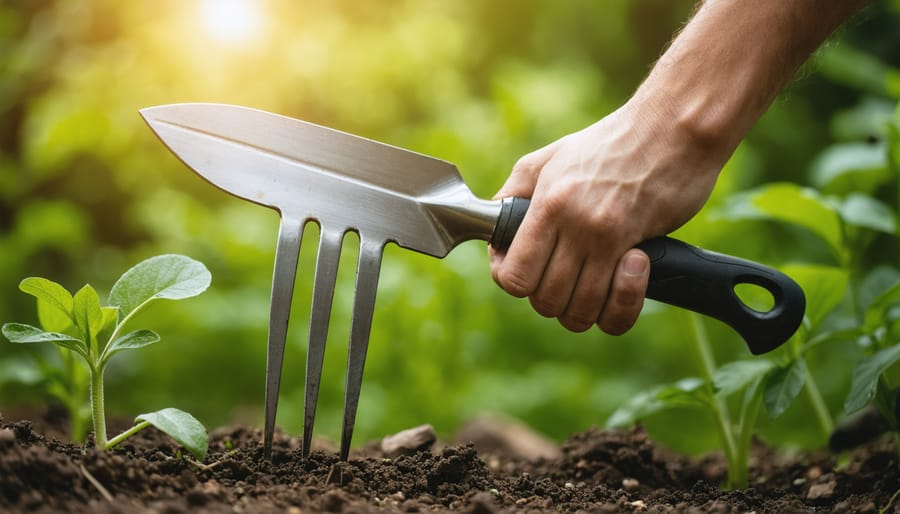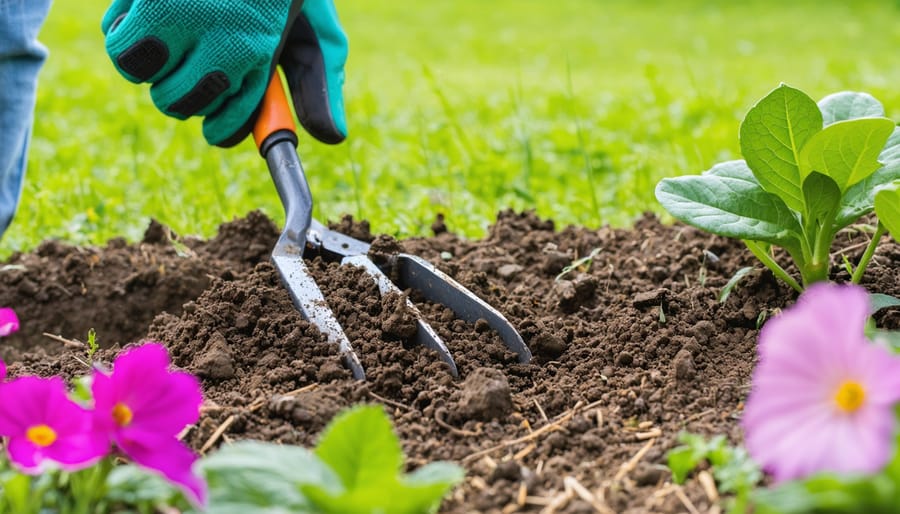Gardening nurtures both body and soul, and physical limitations should never stand between you and your beloved hobby. Modern tools designed for limited mobility have transformed the landscape of accessible gardening, making it possible for everyone to experience the joy of growing plants. From ergonomic handles that reduce joint strain to raised bed systems that eliminate bending, adaptive gardening equipment opens up a world of possibilities for disabled gardeners. Whether you’re managing arthritis, using a wheelchair, or dealing with limited strength, today’s innovative tools and techniques ensure that the therapeutic benefits of gardening remain within reach. This guide explores the essential equipment that makes gardening accessible, comfortable, and enjoyable for gardeners of all abilities, helping you create your perfect outdoor sanctuary without compromise.
Ergonomic Garden Tools That Reduce Strain
Extended-Reach Tools and Telescoping Handles
Extended-reach tools and telescoping handles are game-changers for gardeners who want to maintain their independence while reducing strain on their bodies. These clever tools eliminate the need for bending, stretching, or reaching, making gardening more accessible and enjoyable.
Telescoping handles are particularly versatile, as they can be adjusted to different lengths depending on whether you’re working from a seated position or standing. Most can extend from 18 inches to over 6 feet, allowing you to easily access high branches or deep garden beds. Look for handles with comfortable grips and secure locking mechanisms to prevent unwanted adjustments during use.
Essential extended-reach tools include:
– Long-handled pruners for trimming branches and dead-heading flowers
– Telescoping cultivators for breaking up soil and weeding
– Extended-reach garden trowels for planting and transplanting
– Grabber tools for picking up fallen leaves and garden debris
– Expandable watering wands for reaching hanging baskets and back-of-border plants
When selecting these tools, consider the weight and balance. Lightweight aluminum or carbon fiber materials help prevent fatigue during extended use. Many tools now come with ergonomic features like soft-grip handles and angled heads that make them even more comfortable to use.
For added convenience, look for tools with quick-connect systems that allow you to swap different attachments onto a single handle, reducing the number of tools you need to store and maintain.
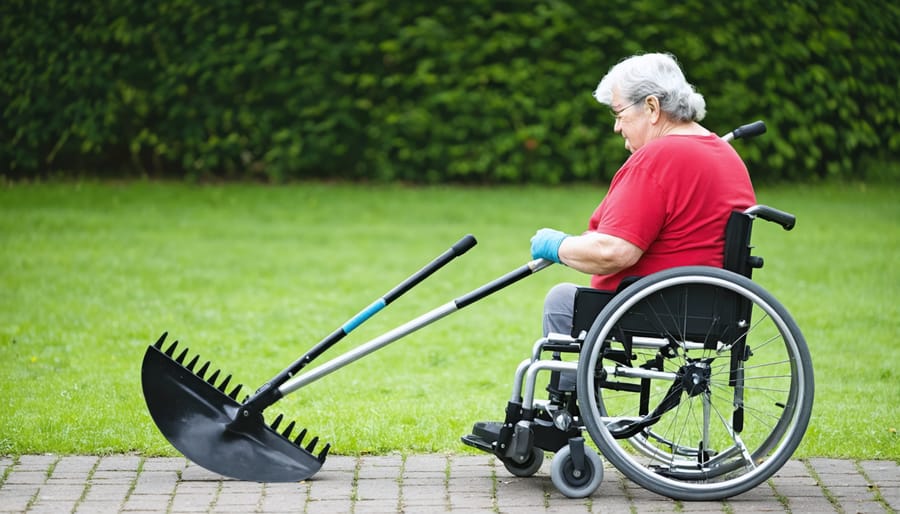
Easy-Grip and Lightweight Tools
When it comes to maintaining your love for gardening, the right tools can make all the difference. Ergonomic hand trowels and other specially designed implements can help reduce strain and make gardening more enjoyable for those with limited hand strength or arthritis.
Look for tools with soft-grip handles made from comfortable materials like memory foam or rubberized compounds. These materials provide excellent grip even when wet and help reduce hand fatigue during extended use. Many manufacturers now offer tools with extended handles that create better leverage, requiring less force to accomplish tasks.
Lightweight aluminum tools are particularly helpful, as they minimize strain while remaining durable enough for regular garden work. Features like wrist supports and ergonomic angles help maintain proper alignment, reducing the risk of injury and discomfort during gardening sessions.
Popular options include:
– Pruners with ratcheting mechanisms that multiply your gripping power
– Trowels and cultivators with curved handles that follow natural hand positioning
– Garden forks with D-shaped grips for better control and stability
– Watering wands with thumb-controlled flow adjusters
– Multi-grip handles that accommodate different holding positions
Remember to choose tools that feel comfortable in your hands – what works for one person might not work for another. Many garden centers now offer “try before you buy” options, allowing you to test the grip and weight before making a purchase.
Raised Garden Beds and Container Solutions
Wheelchair-Accessible Garden Designs
Creating an accessible garden starts with proper dimensions and thoughtful design. For wheelchair users, paths should be at least 36 inches wide to allow comfortable navigation, with turning spaces of 60 inches in diameter at key points. Raised beds are essential and should be 24-30 inches high for comfortable reach from a seated position.
The ideal width for raised beds is 24-36 inches when accessible from one side, or up to 48 inches when reachable from both sides. L-shaped or U-shaped bed configurations maximize accessibility while minimizing reaching distance. Consider including a lip or edge on raised beds that’s sturdy enough to support partial weight, allowing gardeners to lean slightly for better reach.
Vertical gardening elements should be positioned at heights between 24-48 inches. Installing smooth, firm pathways made of concrete, packed gravel, or composite decking ensures easy wheelchair mobility. Include strategic resting spots with shade every 25-30 feet along pathways.
For container gardens, use lightweight materials and place them on rolling platforms or elevated surfaces. Consider installing an automated watering system to reduce the need for frequent watering. These measurements create a comfortable, safe environment that allows wheelchair users to garden independently and enjoyably.
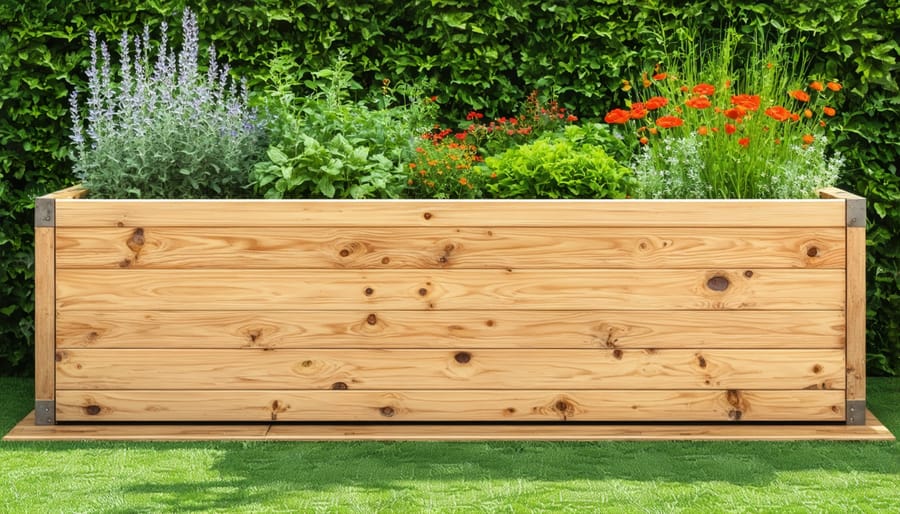
Vertical Gardening Systems
Vertical gardening systems offer an excellent solution for disabled gardeners by bringing plants to accessible heights and maximizing space efficiency. Wall-mounted planters and tiered garden systems can be installed at customized heights, eliminating the need to bend down or reach up uncomfortably. These systems come in various forms, from simple hanging pocket planters to sophisticated hydroponic towers.
Multi-level raised bed systems are particularly beneficial, featuring different tiers that allow gardening from a seated position or while standing. Some popular options include stackable containers, pyramid planters, and wall-mounted grid systems that can accommodate both decorative and edible plants.
For wheelchair users, vertical gardens with rotating panels or adjustable shelving units provide easy access to plants from multiple angles. Self-watering vertical systems are especially helpful, reducing the physical effort needed for regular maintenance. Many modern vertical gardens also incorporate automated irrigation systems, making plant care more manageable.
When setting up a vertical garden, consider using lightweight growing mediums and installing the system where it’s easily reachable from your preferred working position. Look for systems with built-in tool storage and ensure there’s adequate space for mobility aids to maneuver around the garden area.
Smart Watering Solutions
Automatic Irrigation Systems
Automatic irrigation systems are game-changers for gardeners with mobility challenges, offering a reliable way to keep plants thriving without the need for daily manual watering. Timer-based systems can be set up once and left to operate on a schedule, delivering precise amounts of water exactly when needed. These systems typically include easy-to-adjust digital timers that can be mounted at accessible heights and programmed with large, user-friendly buttons.
Smart irrigation systems take convenience a step further by connecting to smartphones or tablets, allowing gardeners to control watering schedules from anywhere. Many of these systems include moisture sensors that automatically adjust watering based on soil conditions and weather forecasts, preventing both over- and under-watering. Some advanced models even offer voice control compatibility, making them particularly suitable for gardeners with limited hand mobility.
For raised beds and container gardens, drip irrigation systems with adjustable emitters are ideal. These can be installed at comfortable working heights and require minimal maintenance once set up. Most systems come with quick-connect fittings that are easy to handle, and the tubing can be arranged to accommodate wheelchair access paths between plants.
Lightweight Hoses and Attachments
Watering your garden should never be a strain, and with modern lightweight hoses and accessible spray attachments, it doesn’t have to be. Look for expandable or ultra-lightweight hoses made from modern materials that weigh up to 50% less than traditional rubber hoses. These innovative designs contract when not in use, making storage easier and reducing the need to drag heavy equipment around.
Quick-connect systems are particularly helpful, allowing you to attach and detach sprayers without struggling with tight connections or threading. Many manufacturers now offer ergonomic grip handles and trigger locks that prevent hand fatigue during extended watering sessions.
Consider installing a hose reel system near your garden beds to eliminate the need for carrying or coiling heavy hoses. Auto-rewind features make cleanup effortless, while swivel bases allow you to water in any direction without tangling. For those with limited grip strength, foam-padded handles and large control dials make adjusting water flow and spray patterns much more manageable.
Remember to position your water source strategically to minimize the distance you need to move with your equipment. This thoughtful setup can make a world of difference in your gardening routine.
Mobile Garden Seats and Kneelers
Rolling Garden Scooters
Rolling garden scooters are game-changers for gardeners who need extra support while tending to their plants. These innovative seats combine mobility with practicality, featuring built-in storage compartments for tools and a comfortable cushioned seat that allows you to work at ground level without strain.
Most models come with sturdy wheels designed to handle various terrain, from paved paths to grass, making it easy to move between garden beds. The seats typically swivel 360 degrees, eliminating the need for awkward twisting or repositioning. Many gardeners particularly appreciate the adjustable height settings, which can accommodate different gardening tasks and individual comfort needs.
Storage options vary by model, but most include tool holders, cup holders, and under-seat compartments for carrying essentials like pruners, trowels, and gardening gloves. Some premium versions even feature extended handles for easy transport and sun umbrellas for shade protection.
Look for models with heavy-duty construction that can support at least 300 pounds, and ensure the wheels are wide enough to provide stability on uneven ground. Water-resistant materials are also important, as these scooters often encounter morning dew or wet soil during gardening sessions.
With proper maintenance, a quality rolling garden scooter can provide years of comfortable, accessible gardening enjoyment.
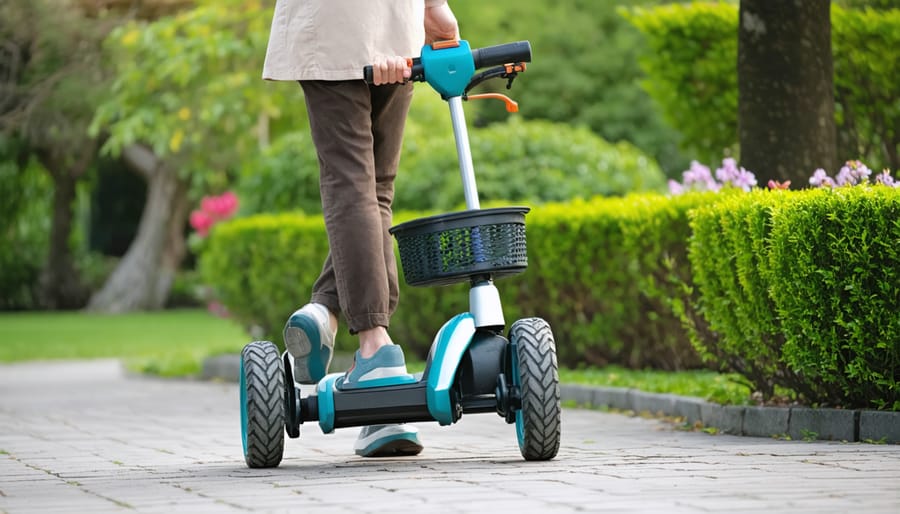
Convertible Kneeler-Seats
Convertible kneeler-seats are ingenious tools that serve a dual purpose in the garden, making them invaluable for gardeners with mobility challenges. These versatile supports can be used either as a padded bench for seated gardening or flipped over to become a cushioned kneeling platform with handles for support when standing up.
When used as a seat, these tools provide a stable, comfortable position for tasks like container gardening or working with raised beds. The padded surface helps reduce pressure on the back and hips, while the sturdy frame ensures safety during use. When flipped to the kneeling position, the handles offer crucial support for lowering down to ground level and rising back up, reducing strain on knees and joints.
Most models feature a lightweight yet durable frame, typically made from powder-coated steel or aluminum, making them easy to move around the garden. The padding is usually weather-resistant and can be wiped clean after use. Some versions even include convenient tool pouches or side pockets to keep gardening implements within easy reach.
For added stability, look for models with locking mechanisms and non-slip feet. Weight capacity varies between models, so check specifications before purchasing to ensure they meet your needs.
Where to Find Adaptive Gardening Equipment
Finding the right adaptive gardening equipment doesn’t have to be challenging. Many specialized retailers and organizations now offer a wide range of smart gardening solutions designed for gardeners with different abilities.
Local garden centers are increasingly stocking adaptive tools, but for the widest selection, online retailers like Enabling Devices, Garden Works, and Life With Ease specialize in accessible gardening equipment. These stores offer detailed product descriptions and often provide customer service representatives who can help you choose the right tools for your specific needs.
Several non-profit organizations and disability resource centers maintain lists of recommended suppliers and sometimes offer equipment lending programs. The American Horticultural Therapy Association’s website features a comprehensive directory of vendors selling adaptive gardening tools.
Don’t overlook medical supply stores, as they often carry ergonomic tools that work well for gardening. Many occupational therapy clinics can also recommend reliable sources for adaptive equipment and might even have connections with local suppliers.
For custom solutions, working with local craftspeople or adaptive equipment specialists can help you modify existing tools or create personalized equipment. Some community gardens and horticultural therapy programs also maintain networks of suppliers and can share valuable recommendations based on their experience.
Remember to check online marketplaces and disability-focused forums, where fellow gardeners often share their favorite equipment sources and personal experiences. Many of these communities offer honest reviews and practical advice about which retailers provide the best service and most durable equipment.
Gardening is a passion that should be accessible to everyone, regardless of physical limitations. By choosing the right adaptive tools and equipment, you can continue to enjoy the therapeutic benefits of tending to your garden while maintaining your independence and confidence. Remember that what works best for one person might not work for another, so take time to experiment with different tools and modifications until you find your perfect fit.
Don’t let physical challenges prevent you from experiencing the joy of watching your plants grow and flourish. With the wide range of adaptive gardening equipment available today, there’s a solution for almost every gardening task. Consider starting small with basic adaptive tools and gradually expanding your collection as you discover what works best for your specific needs.
Most importantly, stay connected with your gardening community. Share your experiences, learn from others, and don’t hesitate to ask for advice or assistance when needed. Your garden is a personal sanctuary where you can continue to create, grow, and thrive. Keep nurturing your love for gardening – it’s a rewarding journey that adapts and grows with you.


